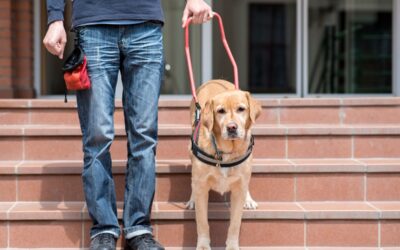Service Dog Vests: Essential Gear or Optional Choice?


What Is a Service Dog Vest?
A service dog vest is a functional accessory that typically displays clear indicators of the dog’s role, such as “Service Dog” or “Do Not Pet.” Designed to identify a working dog, these vests are often brightly colored or have reflective materials for visibility. Some models are even equipped with pockets for IDs or supplies. While the service dog vest is not a legal requirement in the U.S., it can streamline public interactions by making the dog’s purpose more apparent.
Benefits of Service Dog Vests
1. Public Identification
2. Minimizing Interruptions
3. Enhancing Safety
Especially in crowded or busy areas, a visible vest with reflective features can make it easier for people to see and respect your space. Some vests come with handles or attachment points, offering additional control and support for the handler.
Additionally, although a vest is useful for public identification, the only legally required document for your service dog is a Psychiatric Service Dog (PSD) letter. This letter legally qualifies your dog as a service dog and ensures that you can access public spaces without needing further documentation.
U.S. Laws Regarding Service Dog Vests
Let’s tackle the most common misconception: the law for service dog vets. Under the Americans with Disabilities Act (ADA), there is no legal requirement for a service dog to wear a vest or any other indicator. However, the ADA does allow business owners or public spaces to ask only two specific questions:
- Is the dog a service animal required due to a disability?
- What work or task has the dog been trained to perform?
The vest can help answer these questions passively, reducing unnecessary conversation. It’s also worth noting that while emotional support animals (ESAs) have different regulations and do not qualify as service dogs, vests can help differentiate between an ESA and a service dog for clarity.
Traveling & Housing Laws:
Types of Service Dog Vests
1. Basic Vest
2. Harness-Style Vest
3. Reflective Vests
4. Utility Vests with Pockets
How to Get a Psychiatric Service Dog Letter?
If you’re wondering how to legally qualify your service dog, the process of obtaining a Psychiatric Service Dog letter is simple and straightforward with Fast ESA Letter. Here’s how:
- Schedule an Appointment: Register on Fast ESA Letter and book an appointment with a licensed mental health professional.
- Consult Online with a Licensed Healthcare Professional: During your consultation, the professional will evaluate your condition and discuss how a Psychiatric Service Dog can assist with managing your symptoms.
- Receive Your PSD Letter: If the mental health professional determines that a service dog is necessary, they will provide you with an official Psychiatric Service Dog letter.
With the PSD letter in hand, you have the legal backing to confidently take your service dog into public spaces, housing and air travel, without needing to rely solely on a vest to establish your dog’s role.
Additional Gear Options for Service Dogs
For handlers who prefer alternatives or additional gear, several options exist beyond the traditional vest:
- Collar Tags: These small tags can display “Service Dog” and are useful for more casual settings.
- ID Badges: Some handlers use ID badges attached to the dog’s harness, which can be helpful when a vest isn’t practical.
- Leash Wraps: Similar to a vest, a leash wrap can signal that the dog is working, with text like “Service Dog – Do Not Pet.”
These options provide flexibility depending on your environment, ensuring your dog’s role is visible without a full vest if desired.
Key Considerations When Deciding on a Service Dog Vest
When choosing a vest for your service dog, consider these factors to make the best choice:
- Comfort: Your dog’s comfort should be the priority. Choose a vest with padding and an adjustable fit to avoid irritation or movement restrictions.
- Size and Weight: Ensure the vest is appropriately sized for your dog, especially if it will be used for extended periods. Heavy or ill-fitting vests may cause discomfort or limit mobility.
- Durability: Since the vest will be worn frequently, select durable materials that withstand weather and active use.
- Visibility: Bright colors or reflective elements can help others recognize the service dog’s working status, which is especially helpful in crowded areas or at night.
How to Put a Service Dog Vest On?
Where to Get a Service Dog Vest?
- Amazon: Offers a range of service dog vests with customizable options.
- Petco and PetSmart: Local pet stores with a variety of harnesses and vests.
- Activedogs.com: Specialized gear for service dogs, including custom labels.
- Ruffwear: Known for durable, comfortable dog equipment, ideal for active service dogs.
- WorkingServiceDog.com: A wide selection of vests specifically for service and therapy dogs.
How To Maintain Service Dog Vest?
A well-maintained vest is essential for visibility and durability:
- Regular Cleaning: Most vests are machine washable but check tags for specific care instructions.
- Inspect for Wear and Tear: Replace or repair when signs of damage appear.
- Seasonal Considerations: Use breathable materials in summer and reflective options in winter for visibility.
Conclusion
Frequently Asked Questions
Are Dog Vests Necessary for Service Dogs in Training?
Do Service Dog Vests Need to Be a Specific Color?
What Features Should a Good Service Dog Vest Have?
Can I Get a Custom Service Dog Vest with My Dog’s Name?
Are Service Dog Vests Water-Resistant?
Can Anyone Purchase a Service Dog Vest?
How Should a Service Dog Vest Fit?
How Can I Ensure My Service Dog Vest is Comfortable for My Dog?
Do Service Dog Vests Have to Be Worn in Public?
How Much Does a Service Dog Vest Cost?
Post Author
Prince Sharma
Related Articles
Man With Schizophrenia Manages Symptoms With The Help Of A Psychiatric Service Dog
How PSD Helps Manage Symptoms of Schizophrenia?A Psychiatric Service Dog helps manage schizophrenia symptoms by providing emotional support, grounding the individual during hallucinations, and assisting in crisis situations. PSDs offer stability...
Why Do You Need a Psychiatric Service Dog ID Card?
Why Do You Need a Psychiatric Service Dog ID Card?A psychiatrist service dog ID card is not required by the ADA, but it can be helpful in communicating to others that your dog is a trained service animal. A PSD Letter makes it possible.In...
Anxiety and Psychiatric Service Dogs: What You Need To Know.
How Psychiatric Service Dogs Help Manage Anxiety: A Complete GuidePsychiatric service dogs help manage anxiety by providing emotional support and performing specific tasks tailored to their handler's needs. They can detect early signs of anxiety,...
Live and Fly Free with Your PSD!







